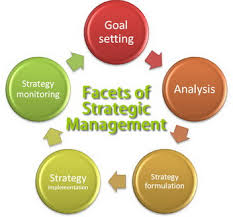Introduction:
Strategic Management is defined as the set of decisions and actions that result in the formulation and implementation of plans designed to achieve a company objectives. It formulate the company’s mission, including broad statements about its purpose, philosophy and goals. Strategic decisions are based on what a manager forecast rather than what they know. In such decisions emphasis is poached on the development of projections that will enable the firm to select the most promising strategic management options. Strategic decisions have complex implications for more areas of the firm. The characteristics of strategic management decisions vary with the level of strategic management activity.
The organization’s Environment
To illustrate the importance of the environment to an organization, consider the analogy of a swimmer crossing a wide stream. The swimmer must assess the current, obstacles, and distance before setting out. If these elements are properly evaluated, the swimmer will arrive at the expected point on the far bank of the stream. But if they are not properly understood, the swimmer might end up too far upstream or downstream. The organization is like a swimmer, and the environment is like the stream. Thus, just as the swimmer needs to understand conditions of its environment to properly maneuver among them.
Organization-environment relationships
The preceding discussion identifies and describes the various dimensions of organizational environments. Because organizations are open systems, they interact with these various dimensions in many different ways. We now turn our attention to these interactions. We first discuss how environments affect organizations and then note a number of ways in which organizati8ons adapt to their environments.
International Environment:
Monitoring the international environment perhaps better thought of as the international dimension of the global environment involves assessing each nondomestic market on the same factors that are used in a domestic assessment. While the importance of factors will differ the same set of considerations can be used for each county. For example, Extent 3-8, Global Strategy in Action. lists name political, legal , and social factor sused to assess international environments. However there is one complication to this crocess namely, the that interplay among international markets must be considered. For example, in recent years. conflicts in the middle east have made collaborative business strategies among firms in traditionally antagonistic countries especially difficult to implement.
Industry environment:
Harvard professor Michael E. Porter propelled the concept of musty environment into the foreground of strategic management thought and business planning the cornerstone of his work first appeared in the Harvard business review: in which porter explains the five forces that shape competition in an industry. His well-defined analytic framework helps strategic managers to link remote factors to their effects on a firm’s operating environment.
Factor Influence the Environment:
The environment consisting of competitive, economic, political, legal and regulatory, technological, and SocioCultural forces, surrounds the buyer and the marketing mix. Marketing mix elements –product, distribution, promotion, price-are factors over which an organization has control; the forces of the environment, however, are subject to far less control. But even though marketers know they cannot predict changes in the marketing environment with certainty, they must nevertheless plan for them. Because these environmental forces have such a profound effect on marketing activities.
The forces of the marketing environment affect a marketer’s ability to facilitate exchanges in three general ways. First, they influence customers by affecting their lifestyles, standards of living, and preferences and needs for products. Because a marketing manager tries to develop and adjust the marketing mix to satisfy consumers, effects of environmental forces on customers also have an indirect impact on marketing mix components. The evolving development of telecommunications and computer technologies, for example, have given FedEx Corporation a new medium for interacting with customers. FedEx is now accessible via America Online, a national computer information service, and through the internet World Wide Web, making it possible for subscribers to brack packages from their home or office computers and send E-mail feedback to FedEx about its products and service. This technology enables FedEx to gather marketing research information about company services directly from consumers. Second, marketing environment forces help determine whether and how a marketing manager can perform certain marketing activities. Third, environmental forces may affect a marketing manager’s decisions and actions by influencing buyer’s reactions to the firm’s marketing mix.
Marketing environment forces can fluctuate quickly and dramatically, which is one reason why marketing is so interesting and challenging. Because these forces are closely interrelated, changes in one may cause changes in others. For example, after starkest, a unit of H.J. Heinz, received letters objecting to dolphin slaughter and faced an organized boycott of its canned tuna, the company announced a dolphin-safe policy and stopped buying tuna from fishing vessels that net dolphins. Starkist’s response to consumer demands ecoed throughout the tuna industry, as other tuna companies quickly adopted dolphin-safe policies to please consumers.
How environments affect organizations:
Three basic perspectives can be used to describe how environments affect organizations: environmental change and complexity, competitive forces, and environmental turbulence. Here he discuss in below how changing the political and ecnomic environment and their effects on strategic mangement decision making.
Environmental Change and complexity:
James D. Thompson was one of the first people to recognize the importance of the organization’s environment. Thompson suggests that the environment can be described along two dimensions: its degree of change and its degree of homogeneity. The degree of change is the extent to which the environment is relatively stable or relatively dynamic. The degree of homogeneity is the extent to which the environment is relatively simple (few elements, little segmentation) or relatively complex (many elements, much segmentation). These two dimensions interact to determine the level of uncertainty faced by the organization. Uncertainty, in turn, is a driving force that influences many organizational decisions. Figure 3.4 illustrates a simple view of the four levels of uncertainty defined by different levels of homogeneity and change.
Kind of clothing buyer but sensitive to fashion-induced changes and compact disc (CD) producers (catering to certain kinds of record buyers but alert to changing tastes in music). Levi Strauss faces few competitors (Wrangler and Lee), has few suppliers and few regulators, and used limited distribution channels. This relatively simple task environment, however, also changes quite rapidly as competitors adjust prices and styles, consumer tastes change, and new fabrics become available.
The External Environment:
The external environment is everything outside an organization that might affect it. Of course, the boundary that separates the organization from its external environment is not always clear and precise. In one sense, for example, stockholders are part of the organization, but in another sense they are part of its environment.
Remote environment :
The remote environment comprises factors that originate beyond, and usually irrespective or, any single firm’s operating situation: (1) economic, (2) Social, (3) political, (4) technological, and (5) ecological factors. That environment presents firms with opportunities, threats, and constraints, but farely does a single firm exert any meaningful reciprocal influence. For example, when the economy slows and construction starts to decrease, an individual contractor is likely to suffer a decline in business, but that contractor’s efforts in stimulating local construction activities would be unable to reverse the overall decrease in construction starts. The trade agreements that resulted from improved relations between the United States and China and the United States and Russia are examples of political factors that impact individual firms. The agreements provided individual U.S. manufacturers with opportunities to broaden their international operations.
Economic factors:
Economic factors concern the nature and direction of the economy in which a firm operates. Because consumption patterns are affected by teh relative affluence of various market segments, each firm must consider economic trends in the segments that affect its industry. On both the national and international level, managers must consider the general availability of credit, the level of disposable income, and the propensity of people to spend. Prime interest rates, inflation rates, and trends in the growth of the gross national product are otehr economic factors they should monitor.
For example, in 2003, the depressed economy was hitting Crown cork & Seal Co. especially hard because it had $2 billion in debt due in the year and not way to raise the money to pay it. The down market had caused its stock price to be too low to raise each as it normally would. Therefore, Crown cork managers turned to issuing bonds to refinance its debt. With the slow market, investors were taking advantage of such bonds because they could safely gain higher returns over stocks. Not only were investors getting a deal, but Crown Cork and other companies were seeing the lowest interest rates on bonds in years and by issuing bonds could reorganize their balance sheets. For more details on this example, read Exhibit 3-2, Strategy in Action.
The emergence of new international power brokers has changed the focus of economic environmental forecasting. Among the most prominent of these power brokers are the European Economic Community (EEC, or common market), the organization of petroleum exporting countries (OPEC), and coalitions of developing countries.
The EEC, whose members include most of the West European countries, eliminated quotas and established a tariff-free trade area for industrial products among its members. By fostering intra-European economic cooperation, it has helped its member countries compete more effectively in non-European international markets.
Political factors:
The direction and stability of political factors are a major consideration for managers on formulating company strategy. Political factors define the legal and regulatory parameters within which firms must operate. Political constraints are placed on firms through fair-trade decisions, antitrust laws, tax programs, minimum wage legislation, pollution and pricing policies, administrative jawboning, and many other actions aimed at protecting employees, consumers, the general public, and the environment. Since such laws and regulations are most commonly restrictive, they tend to reduce the potential profits of firms. However, some political actions are designed to benefit and protect firms. Such actions include patent laws, government subsidies, and product research grant. Thus, political factors either may limit or benefit the firms they influence.
Economic Environment:
Markets require buying power as well as people. The economic environment consists of factors that affect consumer purchasing power and spending patterns. Nations vary greatly in their levels and distribution of income. Some countries have subsistence economics-they consume most of their own agricultural and industrial output. These countries offer few market opportunities. At the other extreme are industrial economics, which constitute rich markets for many different kinds of goods. Marketers must pay close attention to major trends and consumer spending patterns both across and within their world markets. Following are some of the major economic trends in the United Stats.
General Economic conditions
The overall state of the economy fluctuates in all countries. Changes in general economic conditions affect (and are affected by) supply and demand, buying power, willingness to spend, consumer expenditure levels, and the intensity of competitive behavior. Therefore, current economic conditions and changes in the economy have a broad impact on the success of organizations’ marketing strategies. Fluctuations in the U.S. economy follow a general pattern often referred to as the business cycle. In the traditional view, the business cycle consists of four stages: prosperity, recession, depression, and recovery.
During prosperity, unemployment is low and total income is relatively high. Assuming a low inflation rate, this combination causes buying power to be high. If the economic outlook remains prosperous, consumers generally are willing to buy. In the prosperity stage, marketers often expand their product offerings to take advantage of increased buying power. They can sometimes capture a larger market share by intensifying distribution and promotion efforts.
Because unemployment rises during a recession, total buying power declines, pessimism accompanying a recession often stifles both consumer and business spending. As buying power decreases, many consumers become more price-and value-conscious, looking for basic and functional products. During a recession, some firms make the mistake of drastically reducing their marketing efforts, thus damaging their ability to survive. Obviously, marketers should consider some
A depression is a period in which unemployment is extremely high, wages are very low, total disposable income is at a minimum, and consumers lack confidence in the economy. The federal government has used both monetary and fiscal policies to offset the effects of recession and depression. Monetary policies control the money supply, which in turn affects spending, saving, and investment by both individuals and businesses. Through fiscal policies, the government influences the amount of savings and expenditures by altering the tax structure and changing the levels of government spending. Some experts believe that effective use of monetary and fiscal policies can eliminate depressions from the business cycle.
Recovery is the stage of the business cycle in which the economy moves from depression or recession to prosperity. During this period, high unemployment begins to decline, total disposable income increases, and the economic gloom that reduced consumers’ willingness to by subsides. Both the ability and willingness to buy rise. Marketers face some problems during recovery-for example, difficulty in ascertaining how quickly and to what level prosperity will return. In this stage, marketers should maintain as much flexibility in their marketing strategies as possible to be able t make needed adjustments as the economy moves from recession to prosperity.
Types of Economic Environment:
The international marketer must study each country’s economy. Two economic factors reflect the country’s attractiveness as a market: the country’s industrial structure and its income distribution. The country’s industrial structure shapes its product and service needs, income levels, and employment levels. The four types of industrial structures are as follows:
Subsistence economics:
In a subsistence economy, the vast majority of people engage in simple agriculture. They consume most of their output and barter the rest of simple goods and services. They offer few market opportunities.
Raw material exporting economies:
These economics are rich in one or more natural resources but poor in other ways. Much of their revenue comes from exporting these resources. Examples are Chile (tin and copper), Zaire (copper, cobalt, and coffee), and Saudi Arabia (oil). These countries are good markets for large equipment, tools and supplies, and trucks. If these are many foreign residents and a wealthy upper class, they are also a market for luxury goods.
Industrializing economics:
In an industrializing economy, manufacturing economy, manufacturing accounts for 10 to 20 percent of the country’s economy. Examples include Egypt, the Philippines, India, and Brazil. As manufacturing increases, the country needs more imports of raw textile materials, steel, and heavy machinery, and fewer imports of finished textiles, paper products, and automobiles. Industrialization typically creates a new rich class and a small but growing middle class, both demanding new types of imported goods.
Political environment:
Strategic mangement decisions are strongly affected by developments in the political environment. The political environment consists of laws, government agencies, and pressure groups that influence or limit various organizations and individuals in a given society.
In its broadest terms, politics is the art (or science) of public influence and control. Laws are an outcome of the political process that differentiate good and bad conduct. An orderly political process is necessary because modern society is the
Product of an Evolving consensus among diverse individuals and groups, often with conflicting interests and objectives. Although the list of special-interest groups is long and still growing not everyone can have his or her own way. The political system tries to balance competing interests in a generally acceptable manner.
Factors of Political-legal environment:
Nations differ greatly in their political-legal environments. At least four political-legal factors should be considered in deciding whether to do business in a given country, attitudes toward international buying, government bureaucracy, political stability, and monetary regulations.
In their attitudes toward international buying, some nations are quite receptive to foreign firms and others are quite hostile. For example, India has bothered foreign businesses with import quotas, currency restrictions, and limits on the percentage of the management team that can be monnationals. As a result, many U.S. companies left India. In contrast, neighboring Asian shower them with incentives had favorable operating conditions.
A second factor is government bureaucracy the extent to which the host government runs an efficient system for helping foreign companies: efficient customs handling, good market information, and other factors that aid in doing business. A common shock to Americans is how quickly barriers to trade disappear in some countries if a suitable payment (bribe) is made to some official. Political stability is another issue, Governments change hands, sometimes violently. Even without a change, a government may decide to respond to new popular feelings. The foreign company’s property may be taken, its currency holdings may be blocked, or import quotas or new duties may be set. International marketers may find it profitable to do business in an unstable country, but the unstable situation will affect how they handle business and financial matters.
Specific Political Strategies:
Whether acting reactively or proactively, managers can employ four major strategies.
1. Campaign financing, Although federal law prohibits U.S. corporations from backing a specific candidate or party with the firm’s name, funds, or free labor, a legal alternative is available. Corporations can form political action committees (PACs) to solicit volunteer contributions from employees biamnually for the support of preferred candidates and parties. Importantly, PACs are registered with the Federal Election Commission and are required to keep detailed and accurate records of receipts and expenditures. Some criticize corporate PACs for having too great an influence over federal politics. But legislators are reluctant to tamper with a funding mechanism that tends to favor those already in office.
2. Lobbying. Historically, lobbying has been management’s most popular and successful political strategy. Secret and informal meetings between hired representatives and key legislators in smoke-filled rooms have largely been replaced by a more forth right approach. Today, formal presentations by well-prepared company representatives are the preferred approach to lobbying for political support. Despite lobbying reform legislation from the U.S. Congress in response to abuses, loopholes, and weak penalties for inappropriate gifts, it is pretty much business as usual for corporate lobbyists.
3. Coalition building. In a political environment of countless special interest groups, managers are finding that coalitions built around common rallying points are required for political impact.
4. Indirect lobbying. Having learned a lesson from unions, business managers now appreciate the value of grassroots lobbying. Members of legislative bodies tend to be more responsive to the desires of their constituents than to those of individuals who vote in other districts. Employee and consumer letter-writing, telephone, and e-mail campaigns have
Political Forces :
Political, legal, and regulatory forces of the marketing environment are closely interrelated. Legislation is enacted, legal decisions are interpreted by courts, and regulatory agencies are created and operated, for the most part, by elected or appointed officials. Legislation and regulations (or their lack) reflect the current political outlook. Consequently, the political forces of the marketing environment have the potential to influence marketing decisions and strategies.
Marketing organizations must maintain good relations with elected political officials for several reasons. Political officials well disposed toward particular firms or industries are less likely to create or enforce laws and regulations unfavorable to these companies. For example, political officials who believe that oil companies are making honest efforts to control pollution are unlikely to create and enforce highly restrictive pollution control laws. In addition, governments are big buyers, and political officials can influence how much a government agency purchases and from whom. Finally, political officials can play key roles in helping organizations secure foreign markets.
Many marketers view political forces as beyond their control and simply adjust to conditions arising from those forces. Some firms, however, seek to influence political forces. IN some cases, organizations publicly protest the actions of legislative bodies. At times, organizations help to elect to political offices individuals who regard them positively. Much of this help is in the form of campaign contributions. Although laws restrict direct corporate contributions to campaign funds, corporate money may be channeled into campaign funds as corporate executives or stockholders personal contributions. Such actions violate the spirit of corporate campaign contribution laws. A sizable contribution to a campaign fund my carry with it an implicit understanding that the elected official will perform political favors for the contributing firm. A corporation may even contribute to the campaign funds of several candidates who seek the same office. Occasionally, some businesses find it so important to ensure favorable treatment that they make illegal corporate contributions to campaign funds.
The politicization of Management:
Prepared or not and willing or not, today’s managers often find themselves embroiled in issues with clearly political overtones. Just ask the Walt Disney Company. In 1994 Disney abandoned plans to build a history oriented theme park in Virginia in the face of public outcry about dishonoring nearby Civil War battlefields. Another political bombshell exploded in recent years, more and more business managers have swung away from being reactive and become proactive. Why? In short, they view prompt action as a way to avoid additional governmental regulation. The wisdom of choosing a proactive stance is clearly illustrated by the recent experiences of Microsoft and Intel. Both are dominant players in their respective fields of software and computer chips. According to Harvard Business Review.
Economic Variables:
Obviously, general economic conditions and treands are critical to the success of an organization. Wages, prices charged by suppliers and competitors, and government fiscal policies affect both the costs of producing products or offering services and the market conditions under which they are sold. Each i an economic variable.
Common economic indicators measure national income and product, savings, investment, prices, wages, productivity, employment, government activities, and international transactions. All these factors vary over time, and managers devote much of their organizations time and resources to forecasting the economy and anticipating changes. Because economic change is now the norm rather than the exception, this task has become more complicated.
Political variables:
Will a government agency adopt a rigorous or a lenient stance toward the management of a company with which it is dealing? will antitrust laws be rigidly enforced or ignored? will government policy inhibit or encourage management’s freedom to get? These sorts of questions convern political variables, and their answers depend largely on the nature of the political process and other current political climate. The political process involves competition between different interest groups, each seeking to advance its own values and goals. For example, out of the general political debate about the environment, groups emerged which had a direct impact on McDonald’s products and services.
The economic Dimension:
The economic dimension of an organization’s general environment is the overall health of the economic system in which the organization operates. Particularly important economic factors for business are inflation, interest rates, and unemployment, all of which affect demand for different products. During times of inflation, for example, a company pays more for resources and must raise its prices to cover the higher costs. When interest rates are high, consumers are less willing to borrow money and the company itself must pay more when it borrows. When unemployment is high, the company is able to be very se-
models in order to build more Explorers. Schwinn’s lack of awareness about shifts in its sociocultural environment was a major contributor to the firm’s decline.
The political-legal Dimension:
The political-legal dimension of the general environment refers to government regulation of business and the relationship between business and government. It is important for three basic reasons. First, the legal system partially defines what an organization can and cannot do. Although the United States is basically a free market economy, there is still major regulation of business activity. Ford, for example, is subject to a growing concern in Washington about automobile safety standards. Air bags, side reinforcement bars, and child restraining systems are all product changes that have been implemented in part as a result of governmental regulation.
Second, probusiness or antibusiness sentiment in government influences business activity. For example, during periods of probusiness sentiment, firms find it easier to compete and have fewer converns about antitrust issues. On the other hand, during a period of antibusiness sentiment firms may find their competitive strategies more restricted and have fewer opportunities for mergers and acquisitions because of antitrust concerns. Finally, political stability has ramifications for planning. No company wants to set up shop in another country unless trade relationship with that country are relatively well defined and stable. Hence, U.S. firms are more likely to conduct business with England, Mexico, and Canada than with Iran and EI Salvador. Similar issues are also relevant to assessments of local and state governments. A new mayor or governor can affect many organizations, especially small firms that do business in only one location and are susceptible to deed and zoning restrictions and property and school taxes.
The economic Environment challenge of decision making:
Every country is unique and creates a unique set of challenges for man agars trying to do business there. However, three aspects of the economic environment in particular can help managers anticipate the kinds of economic challenges they are likely to face in working abroad.
Economic System: The first of these is the economic system used in the country. As we describe earlier, most countries today are moving toward market economics. In a mature market economy, managers must always consider the importance of the freedom of choice. Consumers are free to make decisions about which products they prefer to purchase, and firms are free to decide what products and services to provide. As long as both the consumer and the firm are free to decide to be in the market, then supply and demand determine which firms
firms and which products are available.
A related characteristics of market economies that is relevant to managers concerns the nature of property ownership. There are two pure types- complete private ownership and complete public ownership. In systems with private ownership, individuals and organizations- not the government – own and operate the companies that conduct business. In systems with public ownership or pure systems of public ownership. Most ….
The political environment challange of decision making:
Yet another environmental challenge facing the international manager is the political/legal environment in which he or she will do business. Four important aspects of the political/legal environment of international management are government stability, incentives for multi-national trade, controls on international trade, and the influence of economic communities on international trade.
Coalitions led to the formation of Unisys Corporation, a large computer firm. Sperry was once one of the United States’ computer giants, but a series of poor decisions put the company on the edge of bankruptcy. Two major executives waged battle for three years over what to do. One wanted to get out of the computer business altogether, and the other wanted to stay in. Finally, the manager who wanted to remain in the computer business, Joseph Kroger, garnered enough support earn promotion to the corporation’s presidency. The other manager, Vincent McLean, took early retirement. Shortly thereafter, Sperry agreed to be acquired by Burroughs Wellcome Co. The resulting combined company is called Unisys.
The impact of coalitions can be either positive or negative. They can help astute managers get the organization on a path toward effectiveness and profitability, or they can strangle well-conceived strategies and decisions. Managers must recognize when to use coalitions, how to assess whether coalitions are acting in the best interests of the organization, and how to constrain their dysfunctional effects.
Conclusion:
Obviously, general economic conditions and treands are critical to the success of an organization for making decision making. Wages, prices charged by suppliers and competitors, and government fiscal policies affect both the costs of producing products or offering services and the market conditions and certenly all these effect the managment decision making.
Common economic environment measure national income and product, savings, investment, prices, wages, productivity, employment, government activities, and international transactions. Because economic change is now the norm rather than the exception, this task has become more complicated.
The total economic environment of a country must effect the business of an organization. Influance of money, high rate of interest etc naturally effect the organization. Managment must be consider all these things to take any strategic management decision making.
Will a government agency adopt a rigorous or a lenient stance toward the management of a company with which it is dealing? will antitrust laws be rigidly enforced or ignored. The political process involves competition between different interest groups, each seeking to advance its own values and goals. All these effects the managerial decision making.
Political environment is the Govt. and Govt. rules and regulations, political parties and organization, political situation of a country. If the political condition of a country is fair then it is suitable for a manager to take any starategic decision making. On the otherhand there will be a lot barriers in every steps of strategic mangement decision making.
















